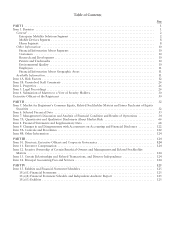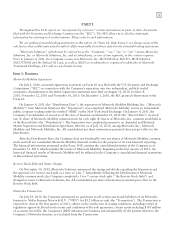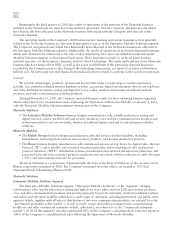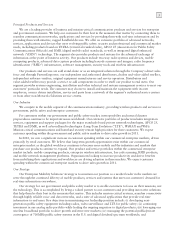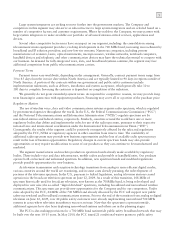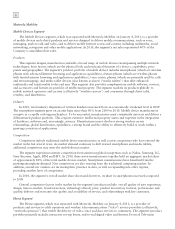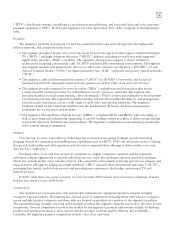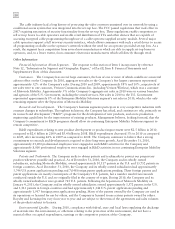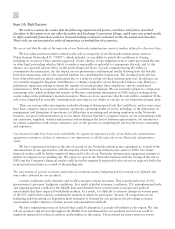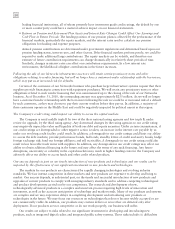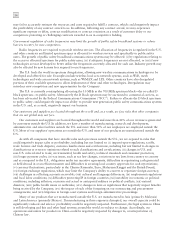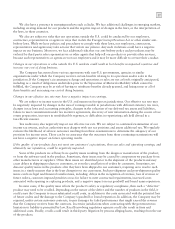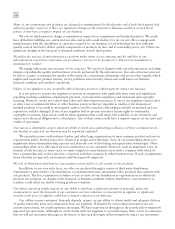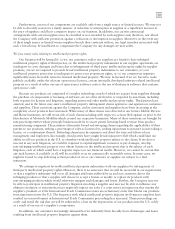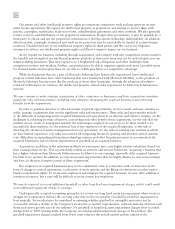Motorola 2010 Annual Report Download - page 18
Download and view the complete annual report
Please find page 18 of the 2010 Motorola annual report below. You can navigate through the pages in the report by either clicking on the pages listed below, or by using the keyword search tool below to find specific information within the annual report.
10
The cable industry had a long history of protecting the video content transmitted over its network by using a
conditional access system that was integrated into the set-top box. The FCC passed regulations that took effect in
2007 requiring separation of security functionality from the set-top box. These regulations enable competitors to
sell set-top boxes to cable operators and enable retail distribution of TVs and other devices that are capable of
accessing encrypted cable programming through use of a cable operator-supplied security module. Several major
cable operators support a full two-way security interface, which allows consumers with such a retail device to access
all programming available on the operator’s network without the need for an operator-provided set-top box. As a
result, the segment faces competition from several new manufacturers which are able to supply set-top boxes to
operators, and, to a lesser extent, from consumer electronics manufacturers which sell directly through retail.
Other Information
Financial Information About Segments. The response to this section of Item 1 incorporates by reference
Note 12, “Information by Segment and Geographic Region,” of Part II, Item 8: Financial Statements and
Supplementary Data of this document.
Customers. The Company has several large customers, the loss of one or more of which could have a material
adverse effect on the Company. In 2010, aggregate net sales to the Company’s five largest customers represented
approximately 32% of the Company’s sales. During 2010 and 2009, approximately 18% and 10%, respectively of
net sales were to one customer, Verizon Communications Inc. (including Verizon Wireless), which was a customer
of Motorola Mobility. Approximately 3% of the Company’s aggregate net sales in 2010 were to various branches
and agencies of the U.S. Government, including the armed services. Net sales in 2010 to the U.S. Government
represented approximately 8% of the Enterprise Mobility Solutions segment’s net sales in 2010, which is the only
remaining segment after the Separation of Motorola Mobility.
Research and Development. The Company’s business segments participate in very competitive industries with
constant changes in technology. Throughout its history, the Company has relied, and continues to rely, primarily on
its research and development (“R&D”) programs for the development of new products, and on its production
engineering capabilities for the improvement of existing products. Management believes, looking forward, that the
Company’s commitment to R&D programs should allow its continuing Enterprise Mobility Solutions segment to
remain competitive.
R&D expenditures relating to new product development or product improvement were $2.5 billion in 2010,
compared to $2.6 billion in 2009 and $3.4 billion in 2008. R&D expenditures decreased 3% in 2010 as compared
to 2009, after decreasing 24% in 2009 as compared to 2008. The Company continues to believe that a strong
commitment to research and development is required to drive long-term growth. As of December 31, 2010,
approximately 21,000 professional employees were engaged in such R&D activities for the Company and
approximately 8,000 professional employees were engaged in R&D activities in our continuing Enterprise Mobility
Solutions segment.
Patents and Trademarks. The Company seeks to obtain patents and trademarks to protect our proprietary
position whenever possible and practical. As of December 31, 2010, the Company and its wholly owned
subsidiaries, including Motorola Mobility, owned approximately 10,117 patents in the U.S. and 13,732 patents in
foreign countries. As of December 31, 2010, the Company and its wholly owned subsidiaries had approximately
3,746 U.S. patent applications pending and 7,048 foreign patent applications pending. These foreign patents and
patent applications are mostly counterparts of the Company’s U.S. patents, but a number result from research
conducted outside the U.S. and are originally filed in the country of origin. During 2010, the Company and its
wholly owned subsidiaries were granted 721 U.S. patents. Following the Separation of Motorola Mobility on
January 4, 2011, the Company and its wholly owned subsidiaries owned approximately 3,572 patents in the U.S.
and 3,113 patents in foreign countries and had approximately 1,342 U.S. patent applications pending and
approximately 1,957 foreign patent applications pending. Many of the patents owned by the Company are used in
its operations or licensed for use by others, and the Company is licensed to use certain patents owned by others.
Royalty and licensing fees vary from year to year and are subject to the terms of the agreements and sales volumes
of the products subject to licenses.
Environmental Quality. During 2010, compliance with federal, state and local laws regulating the discharge
of materials into the environment, or otherwise relating to the protection of the environment, did not have a
material effect on capital expenditures, earnings or the competitive position of the Company.


